This year is definitely the year of new BMW products. I haven’t completely recovered from the freshness brought by the domestic long-wheelbase X5 and i3, and BMW has brought us a brand new 7 series today.

If it weren’t for the pandemic, I might be admiring these two new cars up close at the Beijing Auto Show right now. Although it’s a bit regretful, I still felt a huge excitement when the real car was officially unveiled at the press conference.
As old rivals, the situation where the fuel-powered 7 series is suppressed by the S class must have caused headaches for BMW. And Mercedes-Benz took a step ahead last year by launching the purely electric EQS, which carries the “S class” banner. Although the appearance of the i7 and the new 7 series is a bit slower, believe me, BMW is not being led by its competitors. This carefully crafted new 7 series is a “trump card” in the fields of electric and fuel.
The new 7 series released this time includes the following models:
-
i7 xDrive60
-
760i xDrive
-
M760e xDrive
Without further ado, let’s start with the exterior.
Exterior: From angry to cold-blooded
Let’s first look at the dimensions of the i7: length, width, and height are 5,391 x 1,950 x 1,544 mm, and the wheelbase is 3,215 mm. This data is basically on the same level as the S class.
Starting from the first E23 in 1977, BMW’s iconic kidney grille and angel eye headlights have had a history of more than 40 years on the 7 series. In the time of technological change, “angel eyes” and “kidney grilles” have also changed accordingly.


In the hearts of many BMW fans, “angel eyes” was once synonymous with BMW. However, on the i7, this iconic feature has become a split-style headlight. We first saw this design language on the mid-term facelift of the X7 a while ago, but compared to the mid-term facelift of the X7, the i7, which considered split headlights from the beginning of the design, is undoubtedly more harmonious.
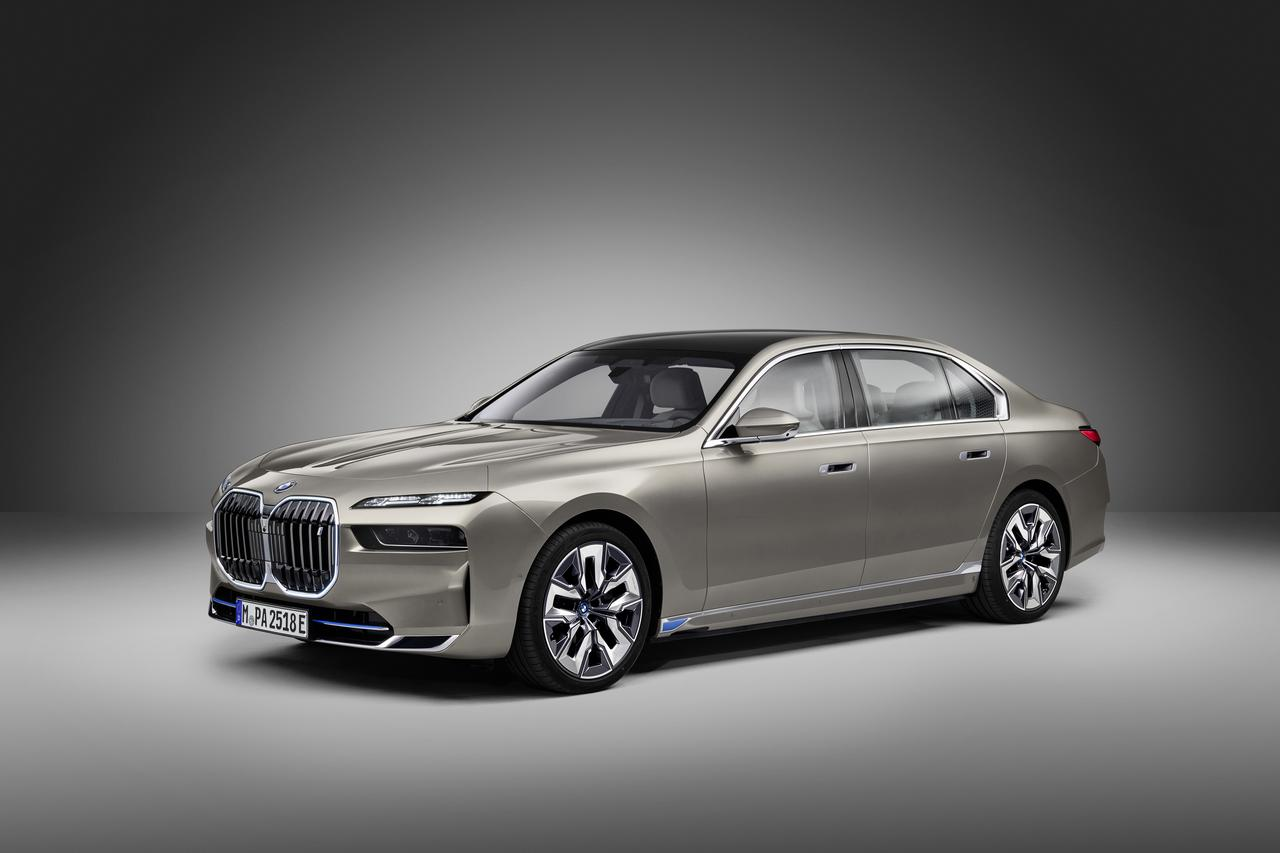 The top of the i7 has slender daytime running lights. If the angel eyes give the impression of “angrily staring,” then the feeling on the i7 is more like “cold and ruthless.” The front and rear logos of the i7 are decorated in blue, and blue elements can also be chosen to decorate the lower side of the air intake, side skirts, and rear spoiler.
The top of the i7 has slender daytime running lights. If the angel eyes give the impression of “angrily staring,” then the feeling on the i7 is more like “cold and ruthless.” The front and rear logos of the i7 are decorated in blue, and blue elements can also be chosen to decorate the lower side of the air intake, side skirts, and rear spoiler.
The completely enclosed double-kidney grille optimizes aerodynamics and this large area grille has a soft contour light at night, which outlines the appearance of the entire front face along with the daytime running lights. Looking at the pictures, the overly large area of the double-kidney grille is slightly strange when lit up at night, but it is impossible to deny its high recognition.
The exterior styles of the 760i and M760e are slightly different from the i7. Compared to the i7, I think the appearance of the fuel version 7 series is the final form: the smoked black decorative panel extends to the bottom of the front face as the background, and the two sporty colored surrounds on both sides blend the slightly abrupt separate headlights into the overall look, lowering the visual center of gravity and reducing the abrupt feeling further.
I estimate that many people may still have regrets about BMW canceling the angel eyes in the short term. However, objectively speaking, the technology of car lighting has made significant progress in recent years, and now the volume can be greatly reduced while ensuring the lighting effect. The bright lines in the exterior design are the “family style,” while the dark lines are the support of current technology. Therefore, it can be anticipated that there will be more conventional designs broken in the front-end design of future vehicles.
Coming to the side of the car body, thanks to the 3,215 mm wheelbase, the i7 looks very slender from the side. To ensure the dignified and imposing atmosphere of a D-class car, the i7’s side design is not extravagant. A muscular sense is created by a straight line from the hood to the rear of the car, and the trim at the bottom of the side is like a well-fitting suit, strengthening the perception of the side’s length.
The new 7 series adopts hidden door handles, and the door opening method is button-style, the same as the iX. The redesigned Hofmeister kink on the C-pillar is still retained as a classic element of BMW. Compared to the well-designed front, the rear design is slightly plain.
The design of the through-type tail lights on the previous generation G11 (G12) 7 Series has disappeared and has been replaced by a more traditional left and right tail light assembly. Although the area of the tail lights is not large, the lighting effect of the LED internal light strip still gives a high-end feel.

There is a small aerodynamic slot on the left and right sides of the lower bumper, but even so, the high-positioned tail lights make the rear of the i7 look a bit top-heavy. In addition, starting from the tail lights, there is an obvious outward protrusion trend in the curve of the rear of the i7, somewhat similar to the thick bumper of the pre- and post-millennium models.
Compared to the i7, I think the appearance of the 7 Series gasoline version surpasses it in the harmony between the new front facia and the overall exterior design.

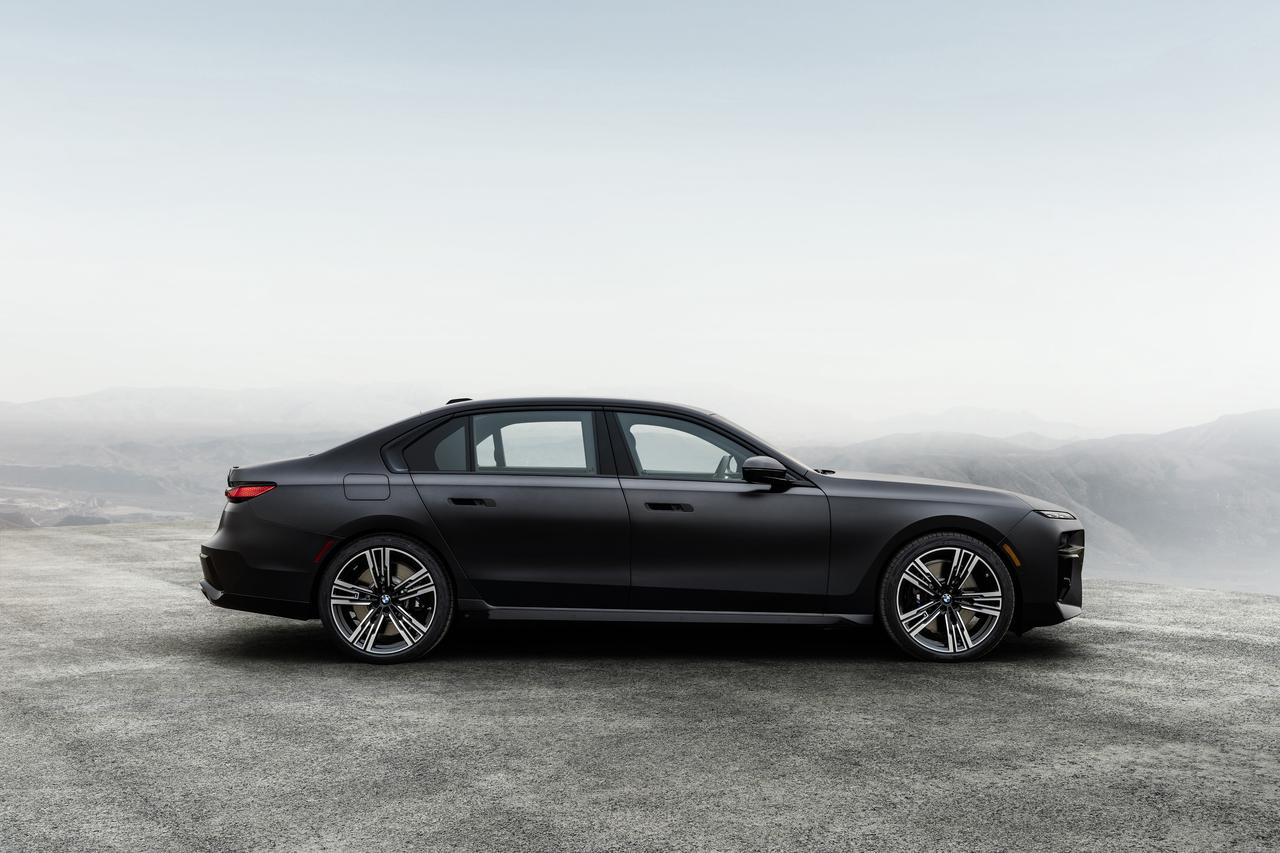

BMW seems to be too concerned about distinguishing between pure electric and gasoline models, which makes the appearance of models such as the i3, iX3, and i7 look less coordinated than the gasoline versions. Fortunately, this sense of disappointment is alleviated after seeing the interior.
Interior: German luxury design
The front row exudes luxury
We have already seen this new family-style interior design from BMW on the iX and the recently launched i3, so seeing the interior of the i7 this time did not cause any surprise. However, this does not mean that this interior is not excellent. If you compare it with the previous generation 7 Series, the interior of the i7 definitely gives people a refreshing feeling.
 Both Audi A8L and Mercedes S-Class entered the era of “large screens” in interior design early on, and the more conservative BMW has finally caught up with its flagship sedan. The integrated floating curved surface screen combines a 14.9-inch touch display and a 12.3-inch digital instrument cluster, and the infotainment system features the brand new BMW iDrive 8.0. iDrive 8.0 upgrades the information processing capability of the infotainment system, allowing the vehicle to perceive more road information ahead of the driver and provide functions such as danger warnings and predicting available parking spaces at the destination. Under iDrive 8.0, the intelligent voice assistant IPA will also receive significant upgrades, enabling more intelligent communication with passengers in the vehicle.
Both Audi A8L and Mercedes S-Class entered the era of “large screens” in interior design early on, and the more conservative BMW has finally caught up with its flagship sedan. The integrated floating curved surface screen combines a 14.9-inch touch display and a 12.3-inch digital instrument cluster, and the infotainment system features the brand new BMW iDrive 8.0. iDrive 8.0 upgrades the information processing capability of the infotainment system, allowing the vehicle to perceive more road information ahead of the driver and provide functions such as danger warnings and predicting available parking spaces at the destination. Under iDrive 8.0, the intelligent voice assistant IPA will also receive significant upgrades, enabling more intelligent communication with passengers in the vehicle.
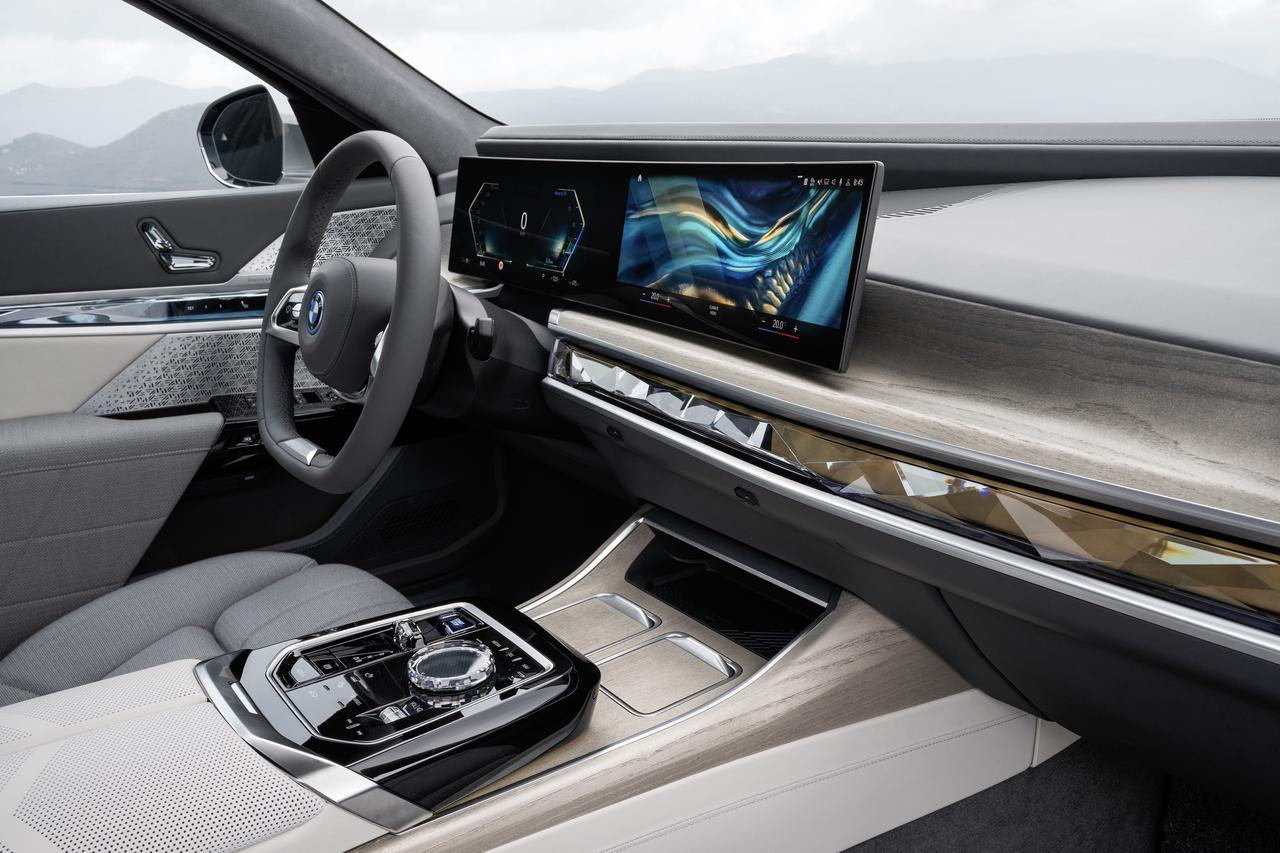
BMW i7’s interpretation of “luxury” differs significantly from the American boldness of the Tesla Model S and the elegance of the Mercedes EQS. In the creation of the atmosphere in the interior, we see a more German-style “convergence” in the i7. The light bars located on the dashboard and doors cleverly combine brightness and softness, and the visual impact does not feel frivolous, but, rather, appropriately creates a sense of luxury.
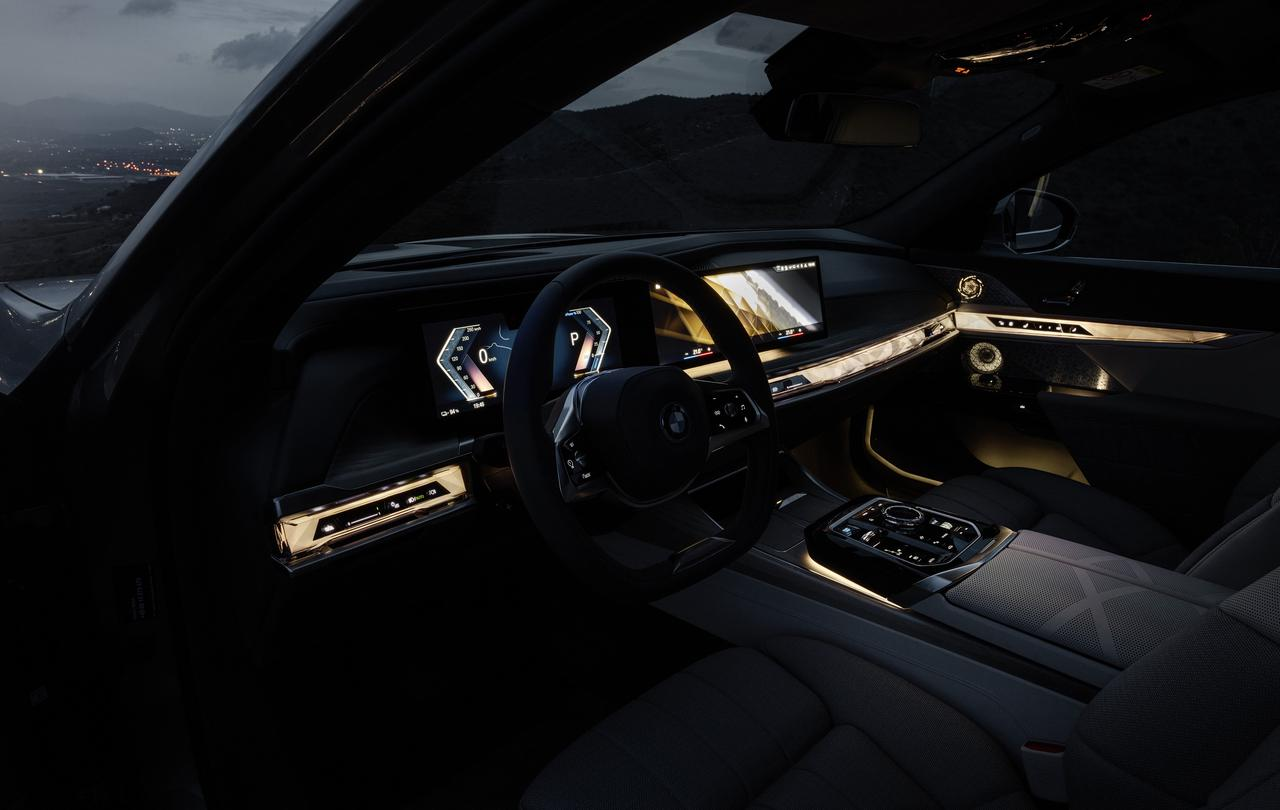
BMW calls this the “Interaction Bar”, and in addition to the lighting effects, it also features touch functionality: the function controls on the lower left of the steering wheel, the air conditioning and multimedia volume controls in the center console area, and the brightness controls for the light strip in front of the front passenger can all be operated by touch.

In the steering wheel area, the i7 adopts a touch + circular up and down dial design. The left side of the steering wheel is the switch for assisted driving, which can adjust speed via the metal dial; the right side is for voice assistants and multimedia quick operation buttons. The metal buttons look incredibly exquisite, but the i7’s circular dial only has two degrees of freedom, up and down, and its functions are limited. If there were some room for customization, it might be better.

 Looking down, the control area in front of the center console is very delicate. The “big chicken leg” gear lever has become a small and exquisite lever. The gear lever, circular iDrive controller, and volume control roller all use similar crystal materials. In addition, the seat adjustment buttons of the i7 are placed above the door panel, similar to the iX.
Looking down, the control area in front of the center console is very delicate. The “big chicken leg” gear lever has become a small and exquisite lever. The gear lever, circular iDrive controller, and volume control roller all use similar crystal materials. In addition, the seat adjustment buttons of the i7 are placed above the door panel, similar to the iX.


Gao Le, President and CEO of BMW Greater China, said at the press conference: “The new 7 Series is restrained luxury.” I completely agree with this point. The interior of the i7 has both the smart touch brought by technology and the calm atmosphere of home. The two seemingly contradictory elements are well balanced in the i7, which is worthy of the new forces in China to learn from.
And that’s not all, the back seat of the new 7 Series is the highlight of this interior.
Unconstrained 31-inch “Big Screen” in the Back Seat
Even as a D-class luxury car, the BMW 7 Series has always been more inclined towards the driver. In this i7, we found that BMW’s focus has actually shifted towards “more towards rear passengers.”

First, let’s take a look at the 31-inch Dehui “big screen” that comes with the car. The 31-inch 8K (7,680 × 2,160) 32:9 OLED screen, together with the 36-speaker Bahua Veken 4D sound system (total power 1,965 W, with vibrators in all four seats), gives people an exaggerated visual experience. The PAD for operating this screen is located on the armrests on the left and right sides of the back seat, and there are also buttons around the PAD to control the door locks, door switches, and privacy sunshades.
The in-car entertainment system supports 5G connection and can play internet streaming content. BMW has already cooperated with local video copyright holders and will support third-party video sites such as iQiyi in the future.

The large screen is usually stored in the roof of the car. Looking up, the new 7 Series also comes with a Sky Lounge panoramic glass sunroof with LED light strips. The nighttime effect is more advanced than the laser dot-matrix roof of the current 5 Series and 7 Series. However, the existence of this large screen slightly affects the integrity of this beautiful ceiling. But this is also a necessary sacrifice for rear passenger comfort.
The i7 also comes with a sizeable seamless leg rest for the VIP seat, and the angle of the rear seat back can be adjusted within the range of 42.5 degrees. Combined with the soft material air headrest, the comfort level is maximized. Customers who buy the 7 Series have always been reluctant to discuss the difference in rear seat comfort compared to the S Class. This issue has been solved in the new 7 Series, and the luxury of the rear seats can be said to be no less than the S Class.

Chassis: The Basics Remain
No need to worry that the BMW i7 will become a large, stable ship with no control. The chassis and handling are BMW’s basic foundation. Let’s take a look at the black technology that the i7 brings to the chassis under electrification.
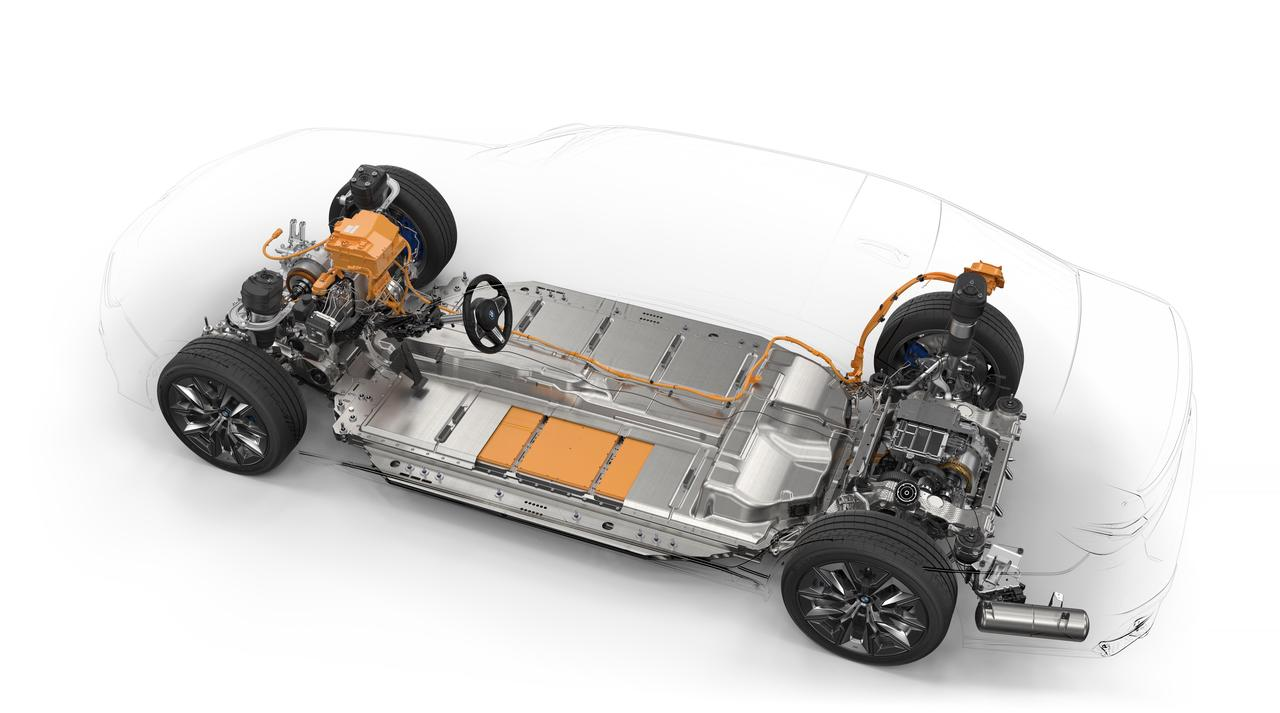
At this level, a double-wishbone and air suspension system are naturally essential. The double-axis adaptive air suspension can dynamically adjust according to vehicle speed and load, and works with the active electric control anti-roll bar, overall rear-wheel steering, and front and rear electronic limited-slip system to improve handling and balance the weight burden of the battery pack. The rear five-link suspension of the i7 has been optimized to ensure that the drive motor can be highly integrated into the rear axle subframe.

As an electric vehicle, optimizing range is also a must-do. The i7 uses 21-inch low rolling-resistance tires and a brake system that integrates kinetic energy recovery, further reducing weight and increasing range.
This chassis configuration is basically the same as that of the BMW iX. A colleague who test drove the iX gave very high praise:
For the dynamic driving part, the iX almost subverted my understanding of large luxury SUVs. While retaining a high level of comfort and silence, the iX’s large size, long wheelbase and weight are cleverly hidden by BMW, and both its posture and dynamic execution are benchmarks.
The physical handling characteristics of a sedan are naturally superior to those of an SUV, and I am very much looking forward to the i7’s actual driving performance.
Powertrain & Intelligent Driving
Powertrain# BMW 7 Series: Oil, Electric, and Hybrid Power All in One
Today, the BMW 7 Series releases oil-powered, electric-powered, and plug-in hybrid versions simultaneously. The 760i gasoline-powered model no longer features a V12 engine, but is replaced with a 4.4 T V8 engine. Meanwhile, the M760e plug-in hybrid model features a dual-turbo 3.0 T S58 engine with an electric motor. The power of these two models is 536 and 571 horsepower respectively.
The focus this time is on the all-electric i7, which is currently available in the i7 xDrive60 with two electric motors and four-wheel drive. Here is some information about the car:
-
Maximum horsepower of 544;
-
Usable battery capacity of 101.7 kWh;
-
WLTP range of 625 km and EPA range of 523 km;
-
Maximum charging power of 195 kW;
-
Maximum energy recovery power of 220 kW;
-
Top speed of 240 km/h.

Later, BMW will release an M high-performance model for the i7, the i7 M70 with a maximum power of around 650 horsepower. This model will also become the most powerful 7 Series in BMW history, set to be released in 2023.
It’s worth noting that the curb weight of the BMW i7 has reached 2,640 kg, but the WLTP average power consumption has reached 18.4-19.6 kWh/100 km, which is a very good level. Even under the harsh EPA conditions, it has a range of 523 km. Thus, the energy control ability of the BMW i7 electric drive system is excellent.

Intelligent Driving
In terms of hardware for intelligent driving (the yellow part in the figure below), the i7 is equipped with BMW’s most powerful perception system:
-
Monocular camera in the front windshield;
-
Forward-looking camera in the grille;
-
Side-view camera on the left and right side mirrors;
-
Millimeter-wave radar located in the center of the grille;
-
Four-corner radar located on the front and rear sides of the car;
-
A total of 12 ultrasonic radar.

 In addition, i7 is equipped with more than 30 auxiliary driving sensors, and in terms of sensing hardware, “material stacking” can reflect the results. In some areas, i7 can support up to level L3 assisted driving, which can recognize traffic lights and park by itself. After installing the Advanced Driver Assistance Package, the allowed speed for adaptive cruise control can reach 210 km/h.
In addition, i7 is equipped with more than 30 auxiliary driving sensors, and in terms of sensing hardware, “material stacking” can reflect the results. In some areas, i7 can support up to level L3 assisted driving, which can recognize traffic lights and park by itself. After installing the Advanced Driver Assistance Package, the allowed speed for adaptive cruise control can reach 210 km/h.
After installing the “Professional Driver Assistance Assistant” package, i7 supports fully hand-free driving on closed roads (such as highways, etc.) in the North American market, and the speed can reach 130 km/h. In the US market, i7 also supports assisted driving according to navigation. Due to differences in localized research and development and regional laws, it is unknown what level of assisted driving i7 can ultimately achieve in the Chinese market.
Conclusion
During the preheating stage of today’s new 7 Series launch event, a friend asked us in the comment section of Weibo: Is i7 an oil-to-electric platform?
“Oil-to-electric” platform refers to the transformation of the original fuel platform to adapt to the production of pure electric vehicles. This type of platform did not consider reserving space for battery packs and motor assemblies for subsequent electrification models during the research and development. The electrification architecture did not have much consideration for intelligence. Therefore, most of these platforms carry some “dirt” from the fuel platform, such as general space, low overall driving efficiency, and poor OTA ability of intelligence.
BMW’s CLAR platform considers compatibility with fuel, pure electric, plug-in hybrid and even hydrogen energy vehicle models from the beginning of research and development. The platform was born as a hybrid, not a pure oil platform, so “oil-to-electric” does not apply to this case. If we want to draw some conclusions, we can use these two points as evaluation criteria:
-
Whether the electric drive energy consumption is better than competitors;
-
Whether the degree of intelligence and OTA ability is better than competitors.
i7 achieved an average WLTP electric energy consumption of 18.4-19.6 kWh/100 km, and the vehicle OTA can be quickly achieved with the on-board 5G system. Of course, what I can’t deny is that because the CLAR platform considers the development of fuel vehicle models, the central floor still has a bulge, which will affect the comfort of rear passengers.
Let’s talk about the target audience of the i7. Audi has yet to launch a pure electric large sedan, Porsche Taycan is quite niche, and the Model S looks too “American” and not enough for business usage. The only option left seems to be the EQS. But to be honest, the EQS is not outstanding in terms of power and luxury, not to mention its awkward appearance for wind resistance optimization.
So, in the field of pure electric executive sedans, at least for China, only the i7 (and Lucid for overseas) is available. Consumers who can afford the i7 are those who dislike the American luxury of the Model S. The arrival of the i7 has given these consumers an “irresistible condition”.
BMW plans to launch 12 pure electric models in the Chinese market by 2023, covering almost all the existing sub-markets. By 2025, at least one-fourth of the BMW cars sold in China will be pure electric. The i7 is not only a step forward in this plan, but also a “show-off” of BMW’s current technology in the field of electrification.
However, the reality to be faced is that BMW does not have its own charging network in China. Currently, it cooperates with third-party providers to offer charging services, except for the charging stations set up in dealerships. This may be a significant obstacle to BMW’s vision for promoting new energy.
Finally, you are welcome to download the Garage App to learn about the latest news of new energy. If you want more immediate communication, you can click here to join our community.
This article is a translation by ChatGPT of a Chinese report from 42HOW. If you have any questions about it, please email bd@42how.com.
